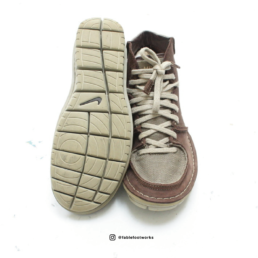
Crazed by Consumption Revisiting Pre-Loved Footwear
I was essentially a creature of habit when it came to find the most elusive sneakers and footwear of the moment. To those embalming their kicks in plastic preservations or staving off wear for best – don’t, sneaker and shoes are meant to be worn. I would even obsessively collect books and magazines to level up on my sneaker and footwear knowledge.
According to the Ellen MacArthur foundation 95% of shoes end up in landfill. This got me thinking that this is probably after only one use. Although used footwear is a bit trickier to resell or donate. Especially thinking of the use of old sneakers the smell can often be a sign of bacteria, so it’s unlikely to be passed on to a new owner.
Footwear is often seen as sector within the fashion industry that is lagging behind in the sustainability conversation.This is largely down to how leather is produced and tanned, in addition Sneakers are frequently manufactured with harmful chemicals that are released into the environment. They are also disposed of in harmful ways, such as incineration or dumping them in landfills, which exposes our environment to these toxic chemicals.
When working in the footwear industry it can feel oxymoronic putting reduce, recycle, repair and apply it to business and a personal practise. Amidst the lockdown period I decided to have a clear out of old footwear and donate trainers I hadn’t worn.
During this period, it’s been a great learning curve to escape the feeling of constantly trying to find things to buy, mainly because I haven’t been around any of my desired retail spaces. Instead I have used this time albeit more efficiently and I am sure this has a positive effect on my mental health as I am more focused on experiencing memorable moments.
I have never been a fast fashion consumer; I would rather opt for purchasing a product made via mindful manufacturing that would foreseeably last me slightly longer but subsequently would cost me more money.
I am asking myself questions before purchasing, can I make do with what I have and what already exists? Also, I have the feeling to rehabilitate old boots and sneakers contacting brands that offer a repair and regeneration service. Conclusively there are many positives found through the new normal. Change is definitely hard and what is inevitable is the future role of designers will definitely evolve into a new space of collaboration and multi-disciplinary thinking. On a deeper level our relationship with products and services needs to change drastically and maybe a good starting point is to reconfigure how we can have more positive relationships with what we have.
I have never been a fast fashion consumer; I would rather opt for purchasing a product made via mindful manufacturing that would foreseeably last me slightly longer but subsequently would cost me more money.
— Andrew Thompson

Related Posts
10th April 2021
Spotlight Bottega Veneta’s footwear and communication
To fully recycle sneakers is very…



